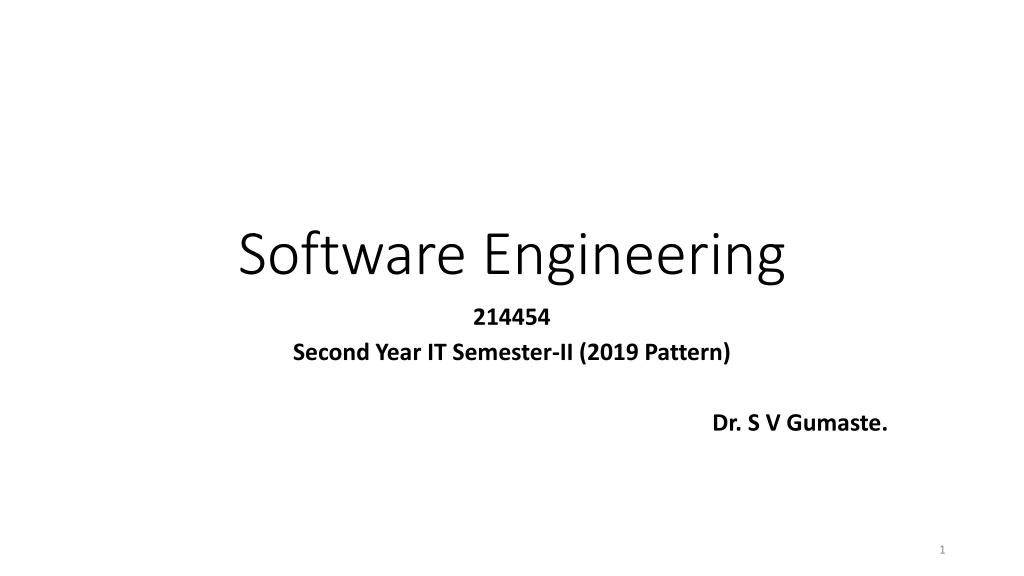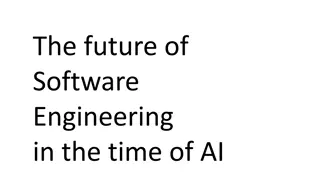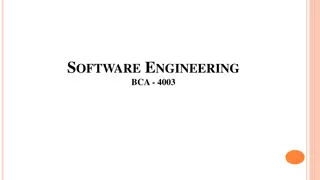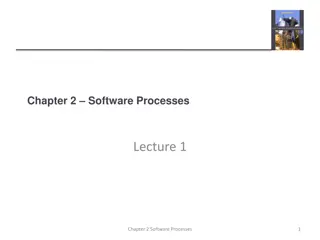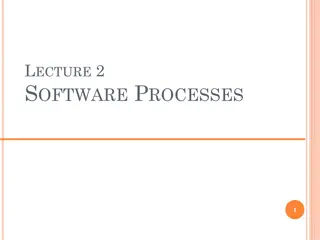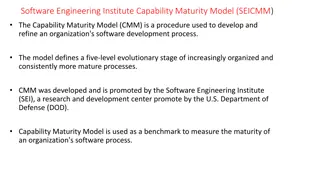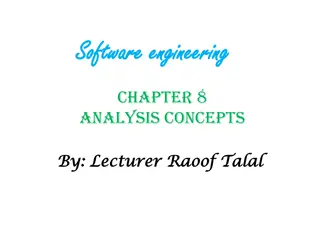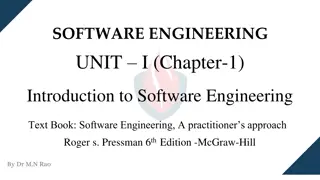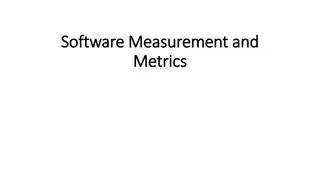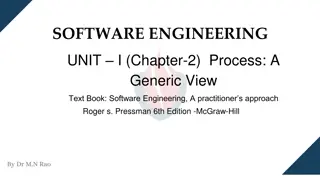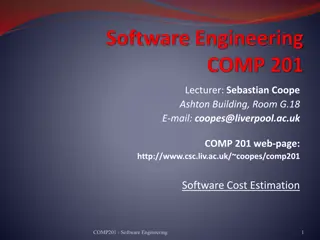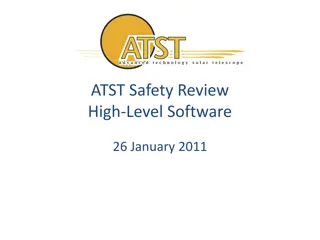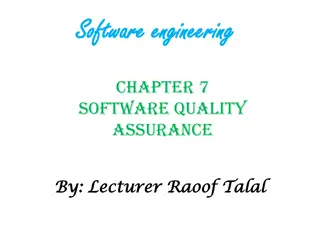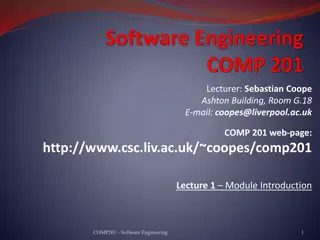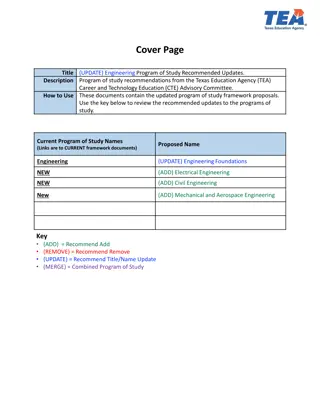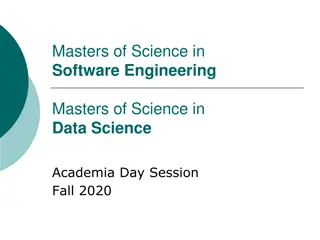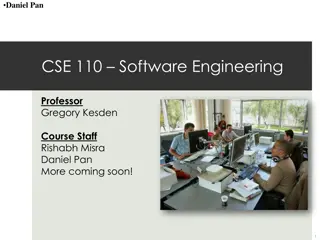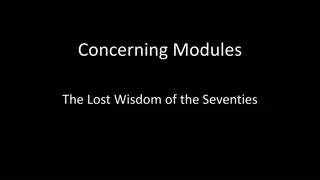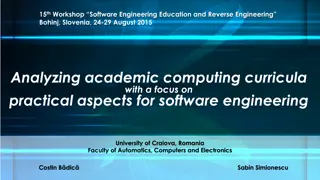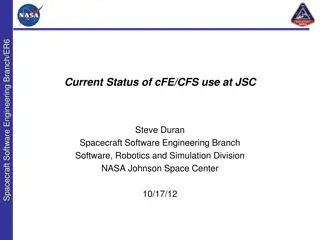Software Engineering
Software engineering in the IT field involves the development and engineering of software through instructions, data structures, and documentation. It explores the differences between software and hardware, emphasizing the custom-built nature of software and its applications in various domains like engineering, scientific research, and embedded systems.
Download Presentation

Please find below an Image/Link to download the presentation.
The content on the website is provided AS IS for your information and personal use only. It may not be sold, licensed, or shared on other websites without obtaining consent from the author.If you encounter any issues during the download, it is possible that the publisher has removed the file from their server.
You are allowed to download the files provided on this website for personal or commercial use, subject to the condition that they are used lawfully. All files are the property of their respective owners.
The content on the website is provided AS IS for your information and personal use only. It may not be sold, licensed, or shared on other websites without obtaining consent from the author.
E N D
Presentation Transcript
Software Engineering 214454 Second Year IT Semester-II (2019 Pattern) Dr. S V Gumaste. 1
What is Software? Software is: (1) instructions (computer programs) that when executed provide desired features, function, and performance; (2) data structures that enable the programs to adequately manipulate information and (3) documentation that describes the operation and use of the programs. 2
What is Software? Software is developed or engineered, it is not manufactured in the classical sense. Software doesn't "wear out." Although the industry is moving toward component-based construction, most software continues to be custom-built. 3
Failure curves for Software: (Wear vs. Deterioration) 5
Software and Hardware Curve: Software is not susceptible to the environmental maladies that cause hardware to wear out. 6
Software Applications System software: OS, Compiler, Editor, Linker, Loader, Assembler Application software: Pay role, Library Management, Hospital Management Engineering/scientific software : Applications range from astronomy to volcanology, from automotive stress analysis to space shuttle orbital dynamics, and from molecular biology to automated manufacturing. Embedded software: Resides within a product or system and is used to implement and control features and functions for the end user and for the system itself. S/W for Washing Machine, ATM 7
S/W Applications: Product-line software: Designed to provide a specific capability for use by many different customers. Product-line software can focus on a limited and esoteric marketplace (e.g., inventory control products) or address mass consumer markets (e.g., word processing, spreadsheets, computer graphics, multimedia, entertainment WebApps (Web applications): WebApps are evolving into sophisticated computing environments that not only provide stand-alone features, computing functions, and content to the end user, but also are integrated with corporate databases and business applications. AI software: Makes use of non-numerical algorithms to solve complex problems. Eg: robotics, expert systems, pattern recognition, AI, gaming 8
SoftwareNew Categories Open world computing Therapid growth of wireless networking may soon lead to true pervasive, distributed computing Ubiquitous and pervasive computing would be in all parts of your life. computing Ubiquitous computing would be everywhere, Netsourcing The World Wide Web is rapidly becoming a computing engine as well as a content provider. The challenge for software engineers is to architect simple and sophisticated applications that provide a benefit to targeted end-user markets worldwide. Open source Growing trend that results in distribution of source code for systems applications (e.g., operating systems, database, and development environments) so that many people can contribute to its development. The challenge for software engineers is to build source code that is self-descriptive, but more importantly, to develop techniques that will enable both customers and developers to know what changes have been made and how those changes manifest themselves within the software 9
Legacy Software: Why must it change? Software must be adapted to meet the needs of new computing environments or technology. Software must be enhanced to implement new business requirements. Software must be extended to make it s ability to work with other more modern systems or databases. Software must be re-architected to make it viable within a network environment. 10
Software Engineering: Some realities: A concerted effort should be made to understand the problem before a software solution is developed design becomes a pivotal activity software should exhibit high quality, software should be maintainable. The seminal definition: [Software engineering is] the establishment and use of sound engineering principles in order to obtain economically software that is reliable and works efficiently on real machines. The IEEE definition: Software Engineering: (1) The application of a systematic, disciplined, quantifiable approach to the development, operation, and maintenance of software; that is, the application of engineering to software. (2) The study of approaches as in (1). 11
Process defines a framework that must be established for effective delivery of software engineering technology. The software process forms the basis for management control of software projects and establishes the context in which technical methods are applied, work products (models, documents, data, reports, forms, etc.) are produced, milestones are established, quality is ensured, and change is properly managed. Methods encompass a broad array of tasks that include communication, requirements analysis, design modeling, program construction, testing, and support. Tools provide automated or semi-automated support for the process and the methods. 13
Umbrella Activities: Software project tracking and control allows the software team to assess progress against the project plan and take any necessary action to maintain the schedule. Risk management assesses risks that may affect the outcome of the project or the quality of the product. Software quality assurance definesand conducts the activities required to ensure software quality. Technical reviews assessessoftware engineering work products in an effort to uncover and remove errors before they are propagated to the next activity. Measurement defines and collects process, project, and product measures that assist the team in delivering software that meets stakeholders needs; can be used in conjunction with all other framework and umbrella activities. Software configuration management managesthe effects of change throughout the software process. Reusability management defines criteria for work product reuse (including software components) and establishes mechanisms to achieve reusable components. Work product preparation and production encompassesthe activities required to create work products such as models, documents, logs, forms, and lists. 14
A process is a collection of activities, actions, and tasks that are performed when some work product is to be created. An activity strives to achieve a broad objective (e.g., communication with stakeholders) and is applied regardless of the application domain, size of the project, complexity of the effort, or degree of rigor with which software engineering is to be applied. An action (e.g., architectural design) encompasses a set of tasks that produce a major work product (e.g., an architectural design model). A task focuses on a small, but well-defined objective (e.g., conducting a unit test) that produces a tangible outcome. 15
Software Myth: Misleading attitudes that have caused serious problems. Management myths: Managers with software responsibility are often under pressure to maintain budgets, keep schedules from slipping, and improve quality. Customer myths: Customer myths lead to false expectations (by the customer) and ultimately, dissatisfaction with the developer. Practitioner s myths: Overconfidence (like It will work!) 16
Management myths: Management myths: Myth: We already have a book that s full of standards and procedures for building software, won t that provide my people with everything they need to know? Reality: The book of standards may very well exist, but isn t used. Most software practitioners aren t aware of its existence. Also, it doesn t reflect modern software engineering practices. 17
Management myths Continued Management myths Continued . . Myth: My people have state-of-the-art software development tools, after all, we buy them the newest computers. Reality: It takes much more than the latest model mainframe, workstation, or PC to do high-quality software development. Computer-aided software engineering (CASE) tools are more important than hardware for achieving good quality and productivity, yet the majority of software developers still do not use them effectively. 18
Management Myth Contd Myth: If we get behind schedule, we can add more programmers and catch up (sometimes called the Mongolian horde concept). Reality: Software development is not a mechanistic process like manufacturing. As new people are added, people who were working must spend time educating the newcomers, thereby reducing the amount of time spent on productive development effort. People can be added but only in a planned and well-coordinated manner. 19
Management Myth Contd Myth: If I decide to outsource the software project to a third party, I can just relax and let that firm build it. Reality: If an organization does not understand how to manage and control software projects internally, it will invariably struggle when it outsources software projects. 20
Customer myths: Customer myths: Myth: A general statement of objectives is sufficient to begin writing programs-we can fill in the details later. Reality: A poor up-front definition is the major cause of failed software efforts. A formal and detailed description of the functions, behavior, performance, interfaces, design constraints, and validation criteria is essential. 21
Customer myths: Customer myths: Myth: Project requirements continually change, but change can be easily accommodated because software is flexible. Reality: It is true that software requirements change, but the impact of change varies with the time at which it is introduced. When changes are requested during software design, the cost impact grows rapidly. Resources have been committed and a design framework has been established. Change can cause heavy additional costs. Change, when requested after software is in production, can be much more expensive than the same change requested earlier. 22
Practitioner Practitioner s myths: s myths: Myth: Once we write the program and get it to work, our job is done. Reality: Industry data indicate that between 60 and 80 percent of all effort expended on software will be expended after it is delivered to the customer for the first time. 23
Practitioner Practitioner s myths cont s myths cont d: d: Myth: Until I get the program running I have no way of assessing its quality. Reality: One of the most effective software quality assurance mechanisms can be applied from the inception of a project the formal technical review. 24
Practitioner Practitioner s myths cont s myths cont d: d: Myth: The only deliverable work product for a successful project is the working program. Reality: A working program is only one part of a software configuration that includes many elements. A variety of work products (e.g., models, documents, plans) provide a foundation for successful engineering and, more important, guidance for software support 25
Generic Process Model/Framework Generic Process Model/Framework Activities: Communication: Planning: Modeling: Analysis of requirements: Design: Construction: Code generation: Testing: Deployment: 26
Process flow: process flow describes how the frame work activities and the actions and tasks that occur within each framework activity are organized with respect to sequence and time 27
Linear process: A linear process flow executes each of the five framework activities in sequence, beginning with communication and culminating with deployment 28
Iterative process An iterative process flow repeats one or more of the activities before proceeding to the next 29
Incremental model The incremental model combines elements of linear and parallel process flows. 30
Incremental Model contd For example, word-processing software developed using the incremental paradigm might deliver basic file management, editing, and document production functions in the first increment; More sophisticated editing and document production capabilities in the second increment; Spelling and grammar checking in the third increment; Advanced page layout capability in the fourth increment. It should be noted that the process flow for any increment can incorporate the prototyping paradigm. 31
Agile software development Agile software development What is it? - Combines a philosophy & a set of development guidelines Who does it? - Project stakeholders Why is it important? - A reasonable alternative to conventional quick look software engineering for certain classes of software and certain types of software projects. It has been demonstrated to deliver successful systems quickly. What are the steps? - The basic framework activities communication, planning, modeling, construction, and deployment remain. But they morph into a minimal task set that pushes the project team toward construction and delivery. What is the work product? - Both the customer and the software engineer have the same view the only really important work product is an operational software increment that is delivered to the customer on the appropriate commitment date. How do I ensure that I ve done it right?-Agile team agrees that the process works, and the team produces deliverable software increments that satisfy the customer. 32
Manifesto for Agile Software Development. It stated that: We are uncovering better ways of developing software by doing it and helping others do it. Through this work we have come to value: Individuals and interactions over processes and tools Working software over comprehensive documentation Customer collaboration over contract negotiation Responding to change over following a plan That is, while there is value in the items on the right, we value the items on the left more. 33
What is agility? Ivar Jacobson provides a useful discussion: Agility has become today s buzzword when describing a modern software process. Every one is agile. An agile team is a nimble team / able to pivot in a new direction as the environment demands, able to appropriately respond to changes. Change is what software development is very much about. Changes in the software being built, changes to the team members, changes because of new technology, changes of all kinds that may have an impact on the product they build or the project that creates the product. Support for changes should be built-in everything we do in software, something we embrace because it is the heart and soul of software. An agile team recognizes that software is developed by individuals working in teams and that the skills of these people, their ability to collaborate is at the core for the success of the project. 34
Agile Process: Any agile software process is characterized in a manner that addresses a number of key assumptions about the majority of software projects: It is difficult to predict in advance which software requirements will persist and which will change. It is equally difficult to predict how customer priorities will change as the project proceeds. For many types of software, design and construction are interleaved. That is, both activities should be performed in tandem so that design models are proven as they are created. It is difficult to predict how much design is necessary before construction is used to prove the design. Analysis, design, construction, and testing are not as predictable (from a planning point of view) as we might like. 36
Agility Principles: [12 Principles] Our highest priority is to satisfy the customer through early and continuous delivery of valuable software. Welcome changing requirements, even late in development. Agile processes harness change for the customer s competitive advantage. Deliver working software frequently, from a couple of weeks to a couple of months, with a preference to the shorter timescale. Business people and developers must work together daily throughout the project. Build projects around motivated individuals. Give them the environment and support they need, and trust them to get the job done. The most efficient and effective method of conveying information to and within a development team is face-to-face conversation. 37
Agility Principles contd Working software is the primary measure of progress. Agile processes promote sustainable development. The sponsors, developers, and users should be able to maintain a constant pace indefinitely. Continuous attention to technical excellence and good design enhances agility. Simplicity the art of maximizing the amount of work not done is essential. The best architectures, requirements, and designs emerge from self organizing teams. At regular intervals, the team reflects on how to become more effective, then tunes and adjusts its behavior accordingly. 38
Some facts/terms: Agile development focuses on the talents and skills of individuals, molding the process to specific people and teams. Competence: talent, specific software-related skills, and overall knowledge of the process that the team has chosen to apply. Common focus: to deliver a working software increment to the customer within the time promised. Collaboration, Mutual trust and respect. Decision-making ability: Team is given autonomy decision-making authority for both technical and project issues. Fuzzy problem-solving ability: agile team will continually have to deal with ambiguity and will continually be buffeted by change. Self-organization. In the context of agile development, self-organization implies three things: (1) Agile team organizes itself for the work to be done, (2) Team organizes the process to best accommodate its local environment, (3) Team organizes work schedule to best achieve delivery of software increment. 39
1. Extreme Programming: In order to illustrate an agile process in a bit more detail, we will study an overview of Extreme Programming (XP), the most widely used approach to agile software development. [Kent Beck, 1980] Beck defines a set of five values that establish a foundation for all work performed as part of XP: Communication - between stakeholders- informal, avoid voluminous documentations Simplicity - XP restricts developers to design only for immediate needs, rather than consider future needs. Feedback - is derived from three sources: the implemented software itself, the customer, and other software team members. Courage - strict adherence to certain Extreme Programming (XP) practices demands courage. A better word might be discipline Respect - Agile team inculcates respect among it members, between other stakeholders and team members, and indirectly, for the software itself. 40
Extreme Programming uses an object-oriented approach as its preferred development paradigm and encompasses a set of rules and practices that occur within the context of four framework activities: planning, design, coding, and testing. Planning: The planning activity (also called the planning game) begins with listening a requirements gathering activity that enables the technical members of the XP team to understand the business context for the software and to get a broad feel for required output and major features and functionality. Design: XP design rigorously follows the KIS (keep it simple) principle. A simple design is always preferred over a more complex representation. Coding: After stories are developed and preliminary design work is done, the team does not move to code, but rather develops a series of unit tests that will exercise each of the stories that is to be included in the current release (software increment). Once the unit test has been created, the developer is better able to focus on what must be implemented to pass the test. Testing: Fixing small problems every few hours takes less time than fixing huge problems just before the deadline. 41
Extreme Programming (XP) Process: Cont'd Class-Responsibility Collaborator 42
Other Agile Process Models: Adaptive Software Development (ASD) Scrum Dynamic Systems Development Method (DSDM) Crystal Feature Drive Development (FDD) Lean Software Development (LSD) Agile Modeling (AM) Agile Unified Process (AUP) All agile process models conform to the Manifesto for Agile Software Development and the Agile principles. 43
2. Adaptive Software Development (ASD) life cycle: Adaptive Software Development (ASD) has been proposed by Jim Highsmith as a technique for building complex software and systems. The philosophical underpinnings of ASD focus on human collaboration and team self-organization. Highsmith argues that an agile, adaptive development approach based on collaboration is as much a source of order in our complex interactions as discipline and engineering and incorporates three phases, speculation, collaboration, and learning. 44
Adaptive Software Development (ASD) People working together must trust one another to (1) criticize without animosity, (2) assist without resentment, (3) work as hard as or harder than they do, (4) have the skill set to contribute to the work at hand, (5) communicate problems or concerns in a way that leads to effective action. 45
3. SCRUM: (Jeff Sutherland and his development team in the early 1990)3 Scrum principles are consistent with the agile manifesto and are used to guide development activities within a process that incorporates the following framework activities: requirements, analysis, design, evolution, and delivery. work tasks occur within a process pattern called a sprint. Backlog A prioritized list of project requirements/features that provide business value for the customer. Items can be added to the backlog at any time The product manager assesses the backlog & updates as required. Sprints Consist of work units that are required to achieve a requirement defined in the backlog that must be fit into a predefined. Scrum meetings Short meetings held daily by the Scrum team. 46
SCRUM Process: Scrum Master 47
4. Dynamic Systems Development Method (DSDM) DSDM is an iterative software process in which each iteration follows the 80 percent rule. approach that provides a framework for building and maintaining systems which meet tight time constraints through the use of incremental prototyping in a controlled project environment . Stages are: Feasibility study Establishes the basic business requirements and constraints associated with the application to be built and then assesses whether the application is a viable candidate for the DSDM process. Business study Establishes the requirements that will allow the application to provide business value; also, defines the basic application architecture and identifies the maintainability requirements for the application. functional and information 48
DSDM Cont'd Functional model iteration Produces a set of incremental prototypes that demonstrate functionality for the customer. The intent during this iterative cycle is to gather additional requirements by eliciting feedback from users as they exercise the prototype. Design and build iteration Revisits prototypes built during functional model iteration to ensure that each has been engineered in a manner that will enable it to provide operational business value for end users. In some cases, functional model iteration and design and build iteration occur concurrently. Implementation Places the latest software increment into the operational environment. It should be noted that (1) the increment may not be 100 percent complete or (2) changes may be requested as the increment is put into place. 49
5. Crystal: Alistair Cockburn, credited as one of the original popularizers of agile, developed the Crystal method for IBM in 1991. He decided to focus not on developing specific step-by-step development strategies that would work across the board for teams involved in any project, but instead to develop guidelines for team collaboration and communication. The traits of Cockburn s Crystal method were therefore all based around the team itself: Human-powered (meaning the project should be flexible and tailored to the needs and the preferred work modalities of people involved) Adaptive (meaning the approach uses no fixed tools but can be altered to meet the team s specific needs) Ultra-light (meaning this methodology does not require much documentation or reporting) 50
